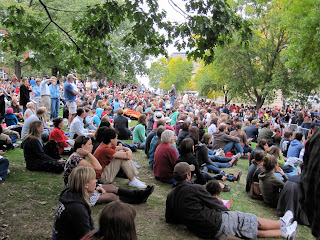Today I failed at getting to see the President of the United States. Obama was speaking at UW as part of a campaign tour for the midterm elections in November. The Senate and Governor races in Wisconsin are pretty close, and I guess that makes the state a key one for the Democrats.
 |
| On Bascomb Hill. Credit: Erin Podolak |
The President spoke on the library mall, which is a pretty small area on campus. The gates were set to open at 3:30 and he was going to go on at 4:45. I joined the line at 2:30 and after waiting until 5:00 was told that the library mall was at capacity and they weren’t going to let anyone else in. Really lame. But, the good news was that the President was late so I hadn’t actually missed anything yet. So, I parked myself on the lawn in front of Bascom Hall so I could at least listen to the speech as it was taking place. The rumor is that 17,000 people made it inside the rally and another 10,000 sat on Bascom Hill where I was.
The event started off with music from
The National and
Ben Harper – although I have to say I enjoyed the Obama transition soundtrack more (Bon Jovi and Bruce, my Jersey loves.) Then, Russ Feingold (Democratic Senator) and Tom Barrett (Democratic Mayor of Milwaukee, and candidate for Governor) each spoke. I’ll keep out of the politics because A. this blog is not political, B. as a journalist it wouldn’t be right for me to give my personal political opinions, C. I know very little about Wisconsin politics.
 |
| Best view in the house. Credit: Erin Podolak |
While we were waiting for the President to take the stage, I found myself thinking about why I voted the way I did in 2008, and the changes that have taken place in the last 20 months that Obama has been in office. Hearing the President speak, and to a large regard defend himself and his party, was a really good experience. Even though I didn’t have a visual, hearing his voice boom out of the PA system was still exciting.
I thoroughly enjoyed the crowd that I was sitting with, there were some very entertaining people around me. My favorite might have been the Republican who kept making snarky remarks to counter what the President was saying, who would occasionally find that he agreed and had to mark those moments by shouting “true dat, true dat.”
There were also a few activists/protesters in the crowd, most of whom I found really annoying. There was one carrying a sign saying that 9-11 was covered up by the government and the attacks really came from within the United States. He made me angry, and I did not mind when the aforementioned Republican decided to heckle him. The same protester was also apparently against the presence of soldiers in Afghanistan.
 |
| Credit: Erin Podolak |
Overall, I am really glad that I stuck it out and stayed outside to hear the President speak live, even if I wasn’t able to get in to actually see him. It was kind of like listening to a gigantic pep talk, that honestly kind of cheered me up a bit. It was the first political rally that I’ve ever attended, but I hope it won’t be my last because even if you don’t agree with the politics of whoever is speaking, it is just great to get out and be around that kind of a group of people to experience that little swatch of the public.
